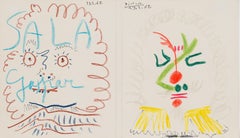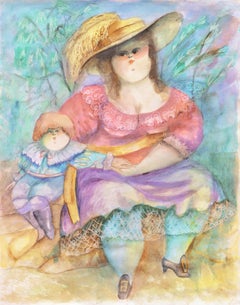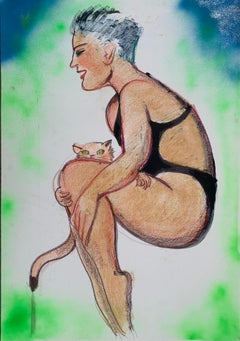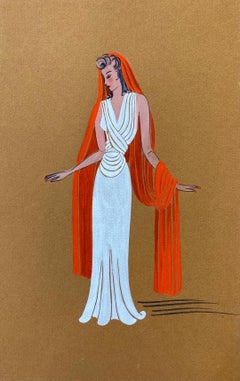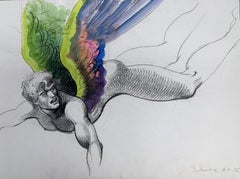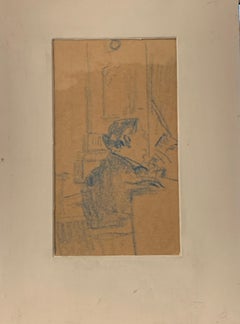Wax Crayon Portrait Drawings and Watercolors
to
1
2
1
1
1
Overall Width
to
Overall Height
to
5
1
1
1
1
2
1
4
1
3
2
1
1
1
1
1
1
1
133
1,506
1,485
1,283
1,148
1
1
2
4
1
Medium: Wax Crayon
Sala Gaspar by Pablo Picasso - Drawing
Located in London, GB
*PLEASE NOTE UK BUYERS WILL ONLY PAY 5% VAT ON THIS PURCHASE.
Sala Gaspar by Pablo Picasso (1881-1973)
Wax crayon and felt-tip pen on paper
23 x 40 cm (9 x 15 ³/₄ inches)
Signed Pic...
Category
1960s Modern Wax Crayon Portrait Drawings and Watercolors
Materials
Paper, Wax Crayon, Felt Pen
'Mother and Child', Bolivian-American Modernist
Located in Santa Cruz, CA
Painted by Norha Beltran (Bolivian-American, 20th century). Accompanied by old label from Hourian Gallery, San Francisco and with comprehensive artist bi...
Category
1970s Wax Crayon Portrait Drawings and Watercolors
Materials
Paper, Wax Crayon, Watercolor
Rousselet, Portrait of an officer, 1915, wax crayon on paper
Located in Paris, FR
Rousselet, French School early 20th century
Portrait of an officier, 1915
Wax crayon on paper
signed "E Rousselet" and dated 1915 lower right
51.5 x 31.5 cm
In quite good condition, ...
Category
1910s Symbolist Wax Crayon Portrait Drawings and Watercolors
Materials
Wax Crayon
Swimmer in the Jump with the Kitten by Marco Silombria. Italian Pop art
Located in Firenze, IT
Swimmer in the Jump with the Kitten by Marco Silombria.
Italian Pop art
Large scale painting on paper.
Mixed tecnique with glitter dust on corners.
Created by Italian Pop - Art ar...
Category
1980s Pop Art Wax Crayon Portrait Drawings and Watercolors
Materials
Paper, Wax Crayon, Mixed Media, Gouache, Color Pencil
Fiat Wedding Cake Car: Irony And Provocation In Marco Silombria's Pop Art.
Located in Firenze, IT
Fiat Wedding Cake Car: Irony and Provocation in Marco Silombria's Pop Art.
Circa 1970
Artist: Marco Silombria
Technique: Mixed media drawing and collage on paper and cardboard
Dime...
Category
Mid-20th Century Pop Art Wax Crayon Portrait Drawings and Watercolors
Materials
Paper, Wax Crayon, Ink, Watercolor, Cardboard, Intaglio
Related Items
The Family
Located in London, GB
'The Family', gouache on fine art paper (1984), by Raymond Dèbieve. In a clear nod to Picasso's influence both stylistically and in terms of subject matter ...
Category
1980s Modern Wax Crayon Portrait Drawings and Watercolors
Materials
Paper, Gouache
1940's Fashion Illustration - Lady In White Dress With Draped Orange Head Scarf
Located in Cirencester, Gloucestershire
Very stylish, unique and original 1940's fashion design by French illustrator Geneviève Thomas.
The painting, executed in gouache and pencil.
The sketch is original, vintage and me...
Category
Mid-20th Century Impressionist Wax Crayon Portrait Drawings and Watercolors
Materials
Gouache
1940's Fashion Illustration - Posed Lady In Vibrant Pink Dress
Located in Cirencester, Gloucestershire
Very stylish, unique and original 1940's fashion design by French illustrator Geneviève Thomas.
The painting, executed in gouache and pencil.
The s...
Category
Mid-20th Century Impressionist Wax Crayon Portrait Drawings and Watercolors
Materials
Gouache
Ecole de Paris Mid 20th Century: Wartime Figures
By Henri Miloch
Located in Cirencester, Gloucestershire
Paris: A Wartime Study of Figures Relaxing in Springtime
by Henri Miloch (1898-1979)
Unsigned
watercolour, graphite and gouache painting on artist's paper, unframed
Sheet: 12.25 x 9...
Category
1940s Impressionist Wax Crayon Portrait Drawings and Watercolors
Materials
Watercolor, Gouache, Graphite
1950s "Purple Head" Mid Century Oil and Pastel Portrait Original Drawing
By Donald Stacy
Located in Arp, TX
Donald Stacy
"Purple Head"
c.1950s
Gouache and oil pastel on paper
13.75" x 17" unframed
Unsigned
Came from artist's estate
Donald Stacy (1925-2008) New Jersey
Studied: Newark School of Fine Art
The Art Students League
Pratt Graphic Arts Center
University of Paris 1953-54
University of Aix-en-Provence 1954-55
Faculty: Art Department of the New School
Museum of Modern Art
School of Visual Arts
Stacy Studio Workshop
Exhibitions: Grand Central Moderns
George Wittenborn
The New School
Print Exhibitions, Chicago
University of Oklahoma
Honolulu Museum
Monclair Museum
Wisconsin State College
Louisiana Art Commission
Philadelphia Print...
Category
Mid-20th Century American Modern Wax Crayon Portrait Drawings and Watercolors
Materials
Paper, Oil Pastel, Gouache
Original-Meeting Van Gogh-Study Master Series-British Awarded Artist-Ink Drawing
Located in London, GB
-In light of new tariffs, we’ve applied a 20% discount off the market price of this piece to support our collectors in facing potential added costs. At the gallery, we work closely w...
Category
2010s Contemporary Wax Crayon Portrait Drawings and Watercolors
Materials
Ink, Archival Paper, Charcoal, Gouache, Acrylic
H 8.27 in W 11.7 in D 0.08 in
Portrait of Vincent Van Gogh with Bandaged Ear and Pipe.
Located in Cotignac, FR
Gouache and watercolour on corrugated cardboard after the famous self portrait by Vincent van Gogh with his fur hat, bandaged ear and pipe. This painting is by Jean Ducel who has pla...
Category
Late 20th Century Wax Crayon Portrait Drawings and Watercolors
Materials
Watercolor, Gouache, Cardboard
1930's Original Parisian Fashion Watercolor Burgandy Dress With Green Cape
Located in Cirencester, Gloucestershire
Very stylish, unique and original 1930's French fashion design, no doubt of Parisian origin.
The painting, executed in gouache/ watercolor and pencil, is dated to the upper corner ...
Category
Mid-20th Century Impressionist Wax Crayon Portrait Drawings and Watercolors
Materials
Watercolor, Gouache, Pencil
La Montera
Located in London, GB
'La Montera', gouache, watercolour and ink on art paper, by Pierre Ambrogiani (circa 1960s). The artist created many artworks with bullfighting as theme. In this case, a single torer...
Category
1960s Expressionist Wax Crayon Portrait Drawings and Watercolors
Materials
Paper, Watercolor, Gouache
Track Star - Figurative Portrait of an African American Man in Pastel on Paper
Located in Soquel, CA
Track Star - Abstracted Portrait of an African American Man in Pastel on Paper
Bold and imaginative pastel drawing of a man in a track suit by an unknown artist (20th Century). An A...
Category
Late 20th Century Expressionist Wax Crayon Portrait Drawings and Watercolors
Materials
Paper, Oil Pastel
H 20 in W 16 in D 0.75 in
Black Panther Trials - Civil Rights Movement Police Violence African American
Located in Miami, FL
The Black Panther Trials - In this historically significant work, African American Artist Vicent D. Smith functions as an Art Journalist/ Court Reporter as much as a
Artist. Here, he depicts, in complete unity, 21 Black Panther Protestors raising their fist of defiance at the White Judge. Smith's composition is about utter simplicity, where the Black Panther Protestors are symmetrically lined up in a confrontation with a Judge whose size is exaggerated in scale. Set against a stylized American Flag, the supercilious Judge gazes down as the protesters as their fists thrust up. Signed Vincent lower right. Titled Panter 21. Original metal frame. Tape on upper left edge of frame. 255 . Panther 21. Framed under plexi.
_____________________________
From Wikipedia
In 1969-1971 there was a series of criminal prosecutions in New Haven, Connecticut, against various members and associates of the Black Panther Party.[1] The charges ranged from criminal conspiracy to first-degree murder. All charges stemmed from the murder of 19-year-old Alex Rackley in the early hours of May 21, 1969. The trials became a rallying-point for the American Left, and marked a decline in public support, even among the black community, for the Black Panther Party
On May 17, 1969, members of the Black Panther Party kidnapped fellow Panther Alex Rackley, who had fallen under suspicion of informing for the FBI. He was held captive at the New Haven Panther headquarters on Orchard Street, where he was tortured and interrogated until he confessed. His interrogation was tape recorded by the Panthers.[2] During that time, national party chairman Bobby Seale visited New Haven and spoke on the campus of Yale University for the Yale Black Ensemble Theater Company.[3] The prosecution alleged, but Seale denied, that after his speech, Seale briefly stopped by the headquarters where Rackley was being held captive and ordered that Rackley be executed. Early in the morning of May 21, three Panthers – Warren Kimbro, Lonnie McLucas, and George Sams, one of the Panthers who had come East from California to investigate the police infiltration of the New York Panther chapter, drove Rackley to the nearby town of Middlefield, Connecticut. Kimbro shot Rackley once in the head and McLucas shot him once in the chest. They dumped his corpse in a swamp, where it was discovered the next day. New Haven police immediately arrested eight New Haven area Black Panthers. Sams and two other Panthers from California were captured later.
Sams and Kimbro confessed to the murder, and agreed to testify against McLucas in exchange for a reduction in sentence. Sams also implicated Seale in the killing, telling his interrogators that while visiting the Panther headquarters on the night of his speech, Seale had directly ordered him to murder Rackley. In all, nine defendants were indicted on charges related to the case. In the heated political rhetoric of the day, these defendants were referred to as the "New Haven Nine", a deliberate allusion to other cause-celebre defendants like the "Chicago Seven".
The first trial was that of Lonnie McLucas, the only person who physically took part in the killing who refused to plead guilty. In fact, McLucas had confessed to shooting Rackley, but nonetheless chose to go to trial.
Jury selection began in May 1970. The case and trial were already a national cause célèbre among critics of the Nixon administration, and especially among those hostile to the actions of the FBI. Under the Bureau's then-secret "Counter-Intelligence Program" (COINTELPRO), FBI director J. Edgar Hoover had ordered his agents to disrupt, discredit, or otherwise neutralize radical groups like the Panthers. Hostility between groups organizing political dissent and the Bureau was, by the time of the trials, at a fever pitch. Hostility from the left was also directed at the two Panthers cooperating with the prosecutors. Sams in particular was accused of being an informant, and lying to implicate Seale for personal benefit.
In the days leading up to a rally on May Day 1970, thousands of supporters of the Panthers arrived in New Haven individually and in organized groups. They were housed and fed by community organizations and by sympathetic Yale students in their dormitory rooms. The Yale college dining halls provided basic meals for everyone. Protesters met daily en masse on the New Haven Green across the street from the Courthouse (and one hundred yards from Yale's main gate). On May Day there was a rally on the Green, featuring speakers including Jean Genet, Abbie Hoffman, Jerry Rubin, and John Froines (an assistant professor of chemistry at the University of Oregon). Teach-ins and other events were also held in the colleges themselves.
Towards midnight on May 1, two bombs exploded in Yale's Ingalls Rink, where a concert was being held in conjunction with the protests.[4] Although the rink was damaged, no one was injured, and no culprit was identified.[4]
Yale chaplain William Sloane Coffin stated, "All of us conspired to bring on this tragedy by law enforcement agencies by their illegal acts against the Panthers, and the rest of us by our immoral silence in front of these acts," while Yale President Kingman Brewster Jr. issued the statement, "I personally want to say that I'm appalled and ashamed that things should have come to such a pass that I am skeptical of the ability of a Black revolutionary to receive a fair trial anywhere in the U.S." Brewster's generally sympathetic tone enraged many of the university's older, more conservative alumni, heightening tensions within the school community.
As tensions mounted, Yale officials sought to avoid deeper unrest and to deflect the real possibility of riots or violent student demonstrations. Sam Chauncey has been credited with winning tactical management on behalf of the administration to quell anxiety among law enforcement and New Haven's citizens, while Kurt Schmoke, a future Rhodes Scholar, mayor of Baltimore, MD and Dean of Howard University School of Law, has received kudos as undergraduate spokesman to the faculty during some of the protest's tensest moments. Ralph Dawson, a classmate of Schmoke's, figured prominently as moderator of the Black Student Alliance at Yale (BSAY).
In the end, compromises between the administration and the students - and, primarily, urgent calls for nonviolence from Bobby Seale and the Black Panthers themselves - quashed the possibility of violence. While Yale (and many other colleges) went "on strike" from May Day until the end of the term, like most schools it was not actually "shut down". Classes were made "voluntarily optional" for the time and students were graded "Pass/Fail" for the work done up to then.
Trial of McLucas
Black Panther trial sketch...
Category
1970s American Modern Wax Crayon Portrait Drawings and Watercolors
Materials
Watercolor, Pen, Pencil, Paper
'Portrait of a Young Man in a Red Tie' French School (1956)
Located in London, GB
'Portrait of a Young Man in a Red Tie', gouache and ink on art paper, French School (1956). Step into the world of mid-20th century European art with a striking portrait that capture...
Category
1950s Modern Wax Crayon Portrait Drawings and Watercolors
Materials
Paper, Ink, Gouache
Previously Available Items
Rainbow Angel. Sketches From The Angelesque Series By Marco Silombria. Year 1986
Located in Firenze, IT
Mixed technique on paper.
Hand signed lower right.
Created by the Italian Pop Art artist Marco Silombria (Savona, 1936-Albissola, 2017): an Italian painter, sculptor, and esteemed a...
Category
1980s Pop Art Wax Crayon Portrait Drawings and Watercolors
Materials
Paper, Charcoal, Wax Crayon, Watercolor
The Conductor , Modern British blue crayon drawing portrait the theatre
By Walter Richard Sickert
Located in Woodbury, CT
Outstanding small oil or wax crayon drawing of a Conductor, inscribed on the original backing from the original time the piece was framed 'The Conductor" either the Old Middlesex or Bedford Theatre, W.R.Sickert.
Both theaters were known places where Sickert painted and sketched.
Unlike the majority of the Camden Town Group, Walter Richard Sickert was recognized during his own life as an important artist, and in the years since his death has increasingly gained a reputation as one of the most influential figures in twentieth-century British art. He was universally acknowledged throughout his life as a colorful, charming, and fascinating character, a catalyst for progress and modernity, yet someone who remained independent of groups, cliques, and categories. As a younger man, he was widely reported to be an entertaining and skilled raconteur, popular within cultural and social circles and friendly with numerous famous personalities of the era. In his old age, he cultivated his many eccentric habits and courted a level of celebrity, frequently appearing in the newspapers for having changed his appearance, his name, or for his latest controversial painting stunt. His art, like his personality, is multifaceted, complex, and compelling.
Sickert was a cosmopolitan figure. The eldest of six children, he was born in Munich on 31 May 1860 to a Danish father (with German nationality) and an Anglo-Irish mother. His early years were spent in Germany, but in 1868 the family moved to England. London remained his principal home for the rest of his life, although he also lived for periods in France and Italy. He spoke fluent English, German and French, and had a good command of Italian. His father, Oswald Adalbert Sickert, was a painter and woodcut illustrator for a comic paper, the Fliegende Blätter, and although his young son received no early formal training, art and culture formed an integral part of his upbringing. His schooling was undertaken in a variety of establishments including the King’s College School, London.
Aged eighteen, Sickert was discouraged from pursuing an artistic career by his father and turned instead to his other great passion, the theatre. Under the alias ‘Mr. Nemo’, he took up acting and appeared in minor roles in several touring productions. Art, however, continued to occupy him and in 1881 he signed up for a year’s ‘General Course’ at the Slade School of Fine Art. The final step towards his chosen path came in 1882 when Sickert abandoned the stage in order to become an apprentice in the studio of his great hero, James Abbot McNeill Whistler (1834–1903). The American artist advised him to leave the Slade, remarking with characteristic acerbic wit, ‘You’ve lost your money, no need to lose your time as well’.1 Sickert’s role under Whistler was largely that of a studio assistant and dogsbody and he learned a good deal of technical and practical knowledge about painting and printmaking. By observation, he also imbibed lessons about Whistler’s painting techniques and began to produce work himself in the style of the master. In 1883 he was entrusted by Whistler to courier his famous Portrait of the Artist’s Mother to the Paris Salon,2 a trip which led to an introduction with the other great influence in his life, Edgar Degas (1834–1917). Over the next five years, he continued to learn from the example of these two great figures of modern painting and began to establish a reputation for himself as a painter of low-toned landscapes. In 1885 he married his first wife Ellen Cobden and the couple spent the summer touring Europe, culminating in a prolonged stay in Dieppe, the town that was to become a beloved fixed constant in his life. He renewed his acquaintance with Degas and made friends with many other young French writers and artists including Jacques-Emile Blanche (1861–1942).
Following Degas’s example, Sickert began to move away from Whistler’s instruction to paint from nature with a wet-in-wet technique. Instead, he established the regime he was to follow for the rest of his life of painting in the studio from drawings made on the spot. By 1887 he had fixed upon the theme which would occupy him intermittently for most of his career, the world of the British music hall, exhibiting his first painting of this subject, Le Mammoth Comique, at the Society of British Artists. A natural platform for his work at this time was the recently formed New English Art Club, which Sickert joined that year. His arrival crystallized a split within the group between the more conservative artists and those who looked to the example of French impressionism. The latter appeared as a breakaway group, the ‘London Impressionists’, in an exhibition at the Goupil Gallery in December 1889, and included, as well as Sickert, Philip Wilson Steer, Frederick Brown, Theodore Roussel, and Sickert’s brother, Bernhard.
Sickert continued to focus on the music hall as a source of inspiration, but also began to concentrate on portraits, domestic scenes from everyday life, and landscapes of Dieppe and Venice, which he visited for the first time in 1895. Following his separation and divorce from Ellen (on the grounds of his adultery) and growing disillusionment with the New English Art Club, Sickert moved to Dieppe where he remained (with occasional sojourns in Venice) until 1906. He continued to exhibit in England but did not return to live there until a chance meeting in Dieppe with the young artist Spencer Gore tempted him back to join the new generation of progressive artists in Britain. Back in London, Sickert established himself in rooms in Camden Town and began to hold Saturday afternoon ‘At Homes’ in his studio in Fitzroy Street. His regular core of visitors became the more formalized ‘Fitzroy Street Group’, an independent, modern exhibiting society which, in 1910, evolved into the Camden Town Group. Sickert exhibited at all three of the group’s exhibitions, although his contributions were markedly different from both the subject matter and visual appearance of the other members. The paintings which drew the most interest from the critics were those which formed the ‘Camden Town Murder’ series, a number of low-toned scenes depicting a naked woman on an iron bedstead, observed by a fully-clothed man. The Camden Town Group later reconfigured into yet another permutation, the London Group, from which Sickert resigned in 1914. That same year he rejoined the NEAC where he exhibited his most famous painting, Ennui (Tate N03846).
During the First World War, Sickert was unable to take his usual summer vacation in Dieppe and began for the first time to form associations with other places, first Chagford in Devon, then Brighton, and later Bath. The war years also saw a concentrated period of etching in a studio in Red Lion Square, London. After the war, Sickert promptly returned to France and settled in Envermeu with his second wife, Christine (whom he had married in 1911). In 1920 Christine died after a long illness and by 1922 Sickert once again moved back to London, this time eschewing Camden Town for nearby Islington. In 1926 he married his third wife: friend and fellow artist Thérèse Lessore
In the later years of his life, Sickert reinvented himself physically, professionally, and artistically. In 1927 he dropped his first name, Walter, and chose instead to be known merely as Richard Sickert. His paintings still featured a familiar range of subjects including domestic interiors, portraits, townscapes, and theatrical subjects but increasingly relied on photographs, instead of drawings, as the basis for his compositions. His work gained a new level of publicity attracting both controversy and respect. Despite some considerable success and the attainment of a level of established respectability (during the 1930s he was elected to the Royal Academy and received honorary degrees from the universities of Manchester and Reading), his poor financial management brought him into difficulties. In 1934, partly as a cost-cutting exercise, he moved to St Peter’s-in-Thanet, near Broadstairs in Kent. In 1938 he moved once again to his final home in Bathampton, Somerset, wherewith the assistance of Thérèse and his long-term supporter Sylvia Gosse he continued painting until just before his death on 22 January 1942.
Sickert’s contribution to British cultural life was not restricted to his artistic output alone. He also exerted considerable influence as a writer and teacher and was a generally proactive, political force in artistic circles. He was a member of numerous societies and groups and played a vital role in the dissemination of new ideas and concepts from France to England. He taught intermittently throughout his life, both in established art institutions such as the Slade, the Westminster School of Art, and the Royal Academy Schools and in his own private schools which he opened and closed with optimistic frequency. He was widely applauded as a gifted and inspirational tutor, teaching, among many, David Bomberg, Winston Churchill, and Lord Methuen. His career as a writer lasted for nearly fifty years, during which time he regularly wrote for a number of publications including the Burlington Magazine, New Age, Art News, and Speaker. In addition, like his former mentor Whistler, he was an inveterate letter writer to the press and bombarded the newspapers with commentary and opinions. His importance as an art critic has been somewhat overlooked, overshadowed by the pre-eminence of contemporaries such as Clive Bell and Roger Fry. Unlike his Bloomsbury colleagues, Sickert did not highly rate the work of the post-impressionists Henri Matisse and Pablo Picasso, and the progressive nature of his writings was therefore underestimated. The publication of his collected writings in 2000, edited by Anna Gruetzner Robins, fully revealed for the first time his extensive contribution to shaping British attitudes to art in his own lifetime.
The first retrospective of Sickert’s work, organized during his lifetime by Lillian Browse, was held in 1941 at the National Gallery. In the same year, the first biography of the artist appeared, written by a friend and pupil, Robert Emmons. After his death, Sickert remained a notable but underestimated figure. His work was well represented in the nation’s public galleries, but he was perceived as problematically independent of the major identified movements in British art. In the latter half of the twentieth century, however, his work was reassessed and his importance revalued. Artists such as Frank Auerbach and the Euston Road School acknowledged a direct link to Sickert’s figurative and domestic interiors. The scholarly work during the 1960s and 1970s of Lillian Browse and Wendy Baron established and formed an invaluable basis for all later Sickert studies. In 1975 Richard Morphet compared Sickert’s use of photo-based source material to the later developments in pop art, and an exhibition at the Hayward Gallery in 1981–2 established the contribution to British modernism of his previously ignored late paintings. In 1992 Wendy Baron and Richard Shone curated a major show at the Royal Academy which provided the first major overview of his entire oeuvre.9 Anna Gruetzner Robins’s 1996 publication, Walter Sickert: Drawings, enhanced his growing reputation with a survey of his work as a draughtsman,10 while in 2000 Ruth Bromberg produced a catalog raisonné of his achievements as a printmaker.11 The nearest publication to a catalog raisonné of paintings and drawings is Wendy Baron’s comprehensive Sickert: Paintings and Drawings published in 2006.12
The twenty-first century has seen a sustained period of Sickert research and exhibitions, crystallizing his reputation as one of the most significant British artists of the early modern period. In addition, his celebrity was assured by the crime fiction writer, Patricia Cornwell, who published a book in 2002 claiming that Sickert was Jack the Ripper. Her assertions caused a schism among Sickert scholars but were widely agreed to be improbable and unsubstantiated. The arguments she propounded in Portrait of a Killer: Jack the Ripper – Case Closed were systematically countered by Matthew Sturgis in the last chapter of his extensive biography, Walter Sickert: A Life, published in 2005.13
This drawing was exhibited at the BADA Antique show circa 2015, the Palm Beach Antique...
Category
Early 1900s Impressionist Wax Crayon Portrait Drawings and Watercolors
Materials
Oil Crayon, Wax Crayon
Wax Crayon portrait drawings and watercolors for sale on 1stDibs.
Find a wide variety of authentic Wax Crayon portrait drawings and watercolors available on 1stDibs. While artists have worked in this medium across a range of time periods, art made with this material during the 21st Century is especially popular. There are many well-known artists whose body of work includes ceramic sculptures. Popular artists on 1stDibs associated with pieces like this include Howard Tangye, and László Moholy-Nagy. Frequently made by artists working in the Contemporary, Expressionist, all of these pieces for sale are unique and many will draw the attention of guests in your home. Not every interior allows for large Wax Crayon portrait drawings and watercolors, so small editions measuring 0.1 inches across are also available Prices for portrait drawings and watercolors made by famous or emerging artists can differ depending on medium, time period and other attributes. On 1stDibs, the price for these items starts at $49 and tops out at $448,500, while the average work can sell for $633.
